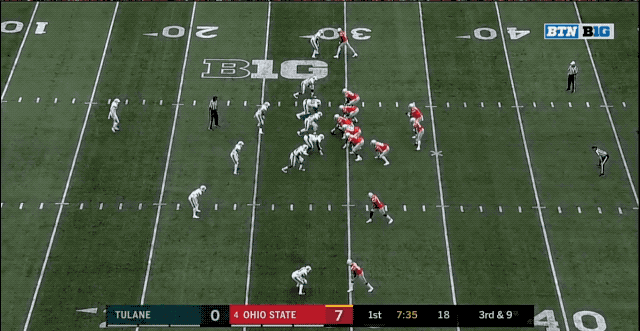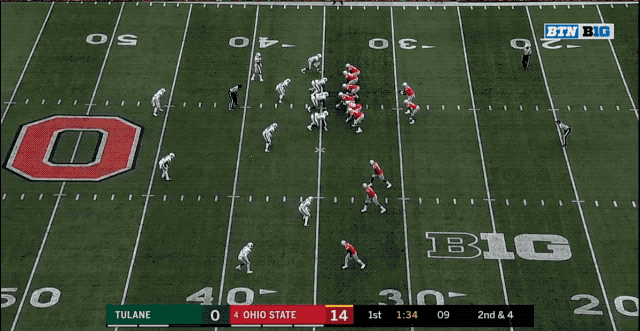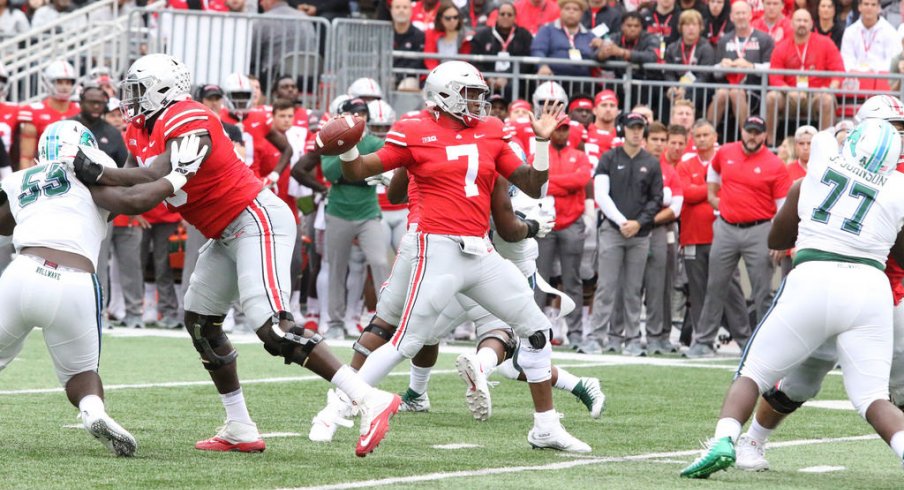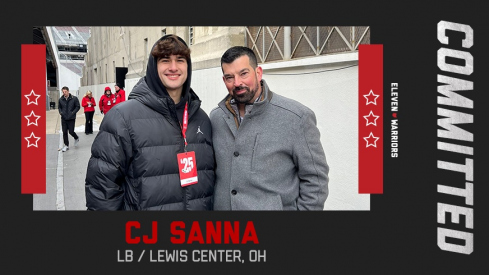"It was a lot of single coverage all over the place." - Urban Meyer following Ohio State's 49-6 victory over Tulane.
After blowing the doors off two Power-5 teams in Oregon State and Rutgers and passing the difficult test presented by TCU in Dallas, nearly everyone expected Ohio State to easily cover a 38-point spread over a 1-2 Tulane team. Unlike years past, the Buckeyes didn't rely on a devastating run game to put away the Green Wave but rather attacked through the air, tallying 419 passing yards as 14 different receivers caught a pass.
While such an aerial outing may sound as if the Buckeyes were the aggressors, trying to show off in advance of next week's matchup with division rival Penn State, the reality was quite the opposite. OSU hardly showed anything in the way of new concepts or schemes, relying instead on the same base play-calls that we've seen over the course of the past two seasons.
Though Meyer's offense began the game with the same uptempo attack seen from both teams the week prior, the ingredients were quite familiar to Buckeye fans. Tight zone reads with attached bubble screen reliefs were the main flavor of the day, with quarterback Dwayne Haskins choosing to throw quickly to speedy wideouts like Parris Campbell in lieu of handing off into a loaded box.

Knowing Haskins was an unlikely runner himself, the Tulane defense played single-high, man-coverage almost exclusively throughout their trip to the Horseshoe, looking to add an extra body to the box in hopes of slowing down J.K. Dobbins and Mike Weber. With a command of the passing game not seen from a Buckeye quarterback in years, Haskins picked apart the one-on-one matchups that littered the field.
"As a defensive coach, you know, when you are a dual-threat quarterback that presents problems," Meyer noted after the game. "If you don’t have a dual-threat quarterback, you better be extremely accurate and make that be legitimate, or it’s going to be hard to run the ball because they’ll load the box on you."
While the running game was relatively quiet for the majority of the game, Dobbins was able to break a few runs for big gains on a gap-run that has been appearing in OSU game plans more and more in recent weeks. The GT-counter is a staple of Oklahoma's explosive, RPO-driven offense under Lincoln Riley, asking both the backside guard and tackle to pull around, forcing the defense to fit two additional gaps on the fly.

After seeing it be so successful for the Sooners in recent years, the Buckeyes have incorporated it quite a bit more frequently this season. The back simply reads the lead of the pulling tackle, waiting to see a hole pop up on the edge.

When Haskins looked to throw on traditional drop back plays, the recipe was a familiar one. Coordinators Ryan Day and Kevin Wilson leaned heavily on the same Mesh, Snag, and Saints concepts we've now seen countless times, simply disguising them with different formations and personnel groups.
Against so much man-coverage, though, the play-callers did dust off one concept that is rarely seen in Columbus. Though All-Go (a.k.a. Verticals or Verts) concepts are extremely popular, especially among coaches with Air Raid roots, Meyer's staff has rarely relied on them in the past.

With the linebackers focused on taking away the backside drag route on a 2nd & 5 in the red zone, Haskins had an easy read for his first of five touchdowns that afternoon. The single safety in the middle of the field retreats to split the difference between the #2 and #3 receivers, expecting a route combination that overloads that side of the field.
But as Campbell gains an inside release off the line, there is no one left to help once he makes his break over the middle. The safety is already too deep, meaning Haskins simply needs to hit the speedy receiver in stride.

Perhaps one reason the Buckeye offense was so adept at reading man-coverage is that they see it so often from their teammates in practice. As usual, defensive coordinator Greg Schiano relied heavily on single-high, man-coverage looks despite the fact that Tulane is a heavy option team, with Meyer even comparing them to a service academy in terms of style.
"A lot of respect for Tulane, triple-option type offense that you have to be assignment sound for the most part," he said afterward. "We played pretty good defense, still can get better, but overall very pleased."
While the Buckeye defense has allowed a number of big gains on the ground this season with so many in the secondary playing with their backs turned to the ball in man coverage, the Green Wave was unable to break any explosive plays. Isaiah Pryor, now entrenched as the starter at boundary safety, played downhill quite aggressively, quickly abandoning his role as the deep centerfielder at the first sign of run to add another defender to the box.
But the biggest reason the Green Wave averaged only 2.4 yards-per-carry was the solid work of Ohio State's front seven, who largely played mistake-free and remained fundamentally sound for long stretches. With aggressive and athletic defensive ends like Chase Young and Jonathan Cooper, Schiano tasks them with playing downhill and attacking the dive on any option runs, leaving the quarterback and exchanging responsibilities with the inside linebacker.

As Young makes the play above, you can see Tuf Borland coming up to corral the quarterback on a keeper, leaving the middle of the field. This scrape-exchange only works if the end stays aggressive on the handoff, closing the distance on the ballcarrier before he hits the hole.
However, just as the Buckeye offense found success with the GT counter against man-coverage, so did Tulane.

While Young and outside linebacker Pete Werner diagnose the play quickly, coming upfield to intercept the pulling guard and tackle, there is still an extra gap that is left unfilled by the Buckeye defense. Though Borland makes a great play to get off the down block of the front side tackle, he doesn't have enough momentum to slow down the runner who already has a head of steam while the secondary is busy covering a post pattern down the field.
Plays like these have left many Buckeye fans nervous about the defense's ability to slow down a Penn State offense that has been one of the nation's most explosive this season. The Nittany Lions lead the nation in touchdowns with 31 through four games, while averaging an impressive 514 yards-per-game.
Though former coordinator Joe Moorhead left to take over at Mississippi State this season, his RPO-heavy system is still in place in State College with new play-caller Ricky Rahne.
As Moorhead explained of the offense last spring in an appearance on The Solid Verbal,
“I sometimes refer to our offense as the Chipotle offense. There’s not a ton of ingredients but there’s a ton of mixing and matching going on. You have a few things you can hang your hat on and through different tags and RPO aspects, you can change the presentation and make it look like you are doing more than you actually are.”
While the Nittany Lions put up 38 points in their visit to Ohio Stadium last season, they amassed a season-low 283 yards against Schiano's defense, with star running back Saquon Barkley only escaping for one big gain throughout the afternoon. One major reason was Schiano's multiplicity in scheme, mixing in zone and pattern-matching schemes more than at any other time last season.
It certainly helped to have Nick Bosa, who is currently out with a core injury, on the field to collapse PSU blocking schemes and take down the electric Barkley before he ever got going. Without him, Young and Cooper must be aggressive while remaining fundamentally sound, ensuring his successor, Miles Sanders, doesn't find any open seams.
Last season, the Buckeyes learned early on about the dangers of playing man-coverage against a creative offense like Oklahoma's and were able to rectify those mistakes when the Lions came to town a month and a half later. This year, though they may not have shown much against Tulane in their final tune-up before heading to Happy Valley, one would imagine the Buckeye coaching staff will once again unleash the full depth of the playbook on both sides of the ball when facing their stiffest competition in the Big Ten East.



